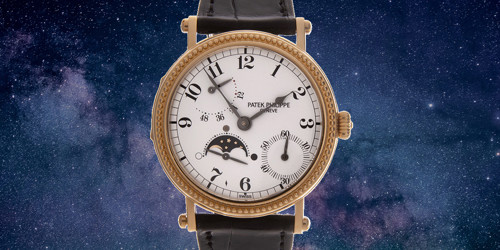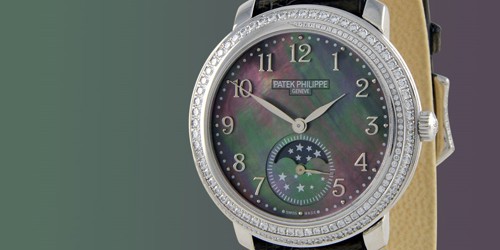A Guide to the Moonphase Complication
The moonphase may not be the world’s most accurate complication, but it is certainly one of the most collectable. David Duggan explores the history and craftsmanship of the moonphase in his latest in depth article.

Inspired by our fascination with the celestial, the moonphase may not be the world’s most accurate complication, but it is certainly viewed as one of the most aesthetic and collectible. So, what makes this particular complication so special? Here, David Duggan explores the history and craftsmanship of the moonphase, and chooses some of his favourite and most collectible models.
What is a moonphase complication?
A moonphase watch displays the sunlit portion of the moon as observed from Earth at any given point during each 29.5-day lunar month. That’s the time it takes to get from a new moon, when it’s not visible, to a full moon and back again.
Who invented it?
The moonphase complication was first developed for a wristwatch by Patek Philippe in 1925, before Rolex introduced its own interpretation of the complication in 1949 with the Reference 8171.
How does it work?
Most commonly, the moonphase is displayed through a crescent-shaped aperture to identify the waxing and waning phases of the Moon. This is known as a ‘bosom’ moonphase watch, where two identical moons sit on a disc under the watch dial. The disc is controlled by a 59-tooth driving wheel, which uses a mechanical finger to advance the disc one notch every 24 hours. When a lunar cycle is complete, the second moon appears in the aperture, hence the total of 59 teeth (29.5 x 2).
![]()

Another way of displaying the phases of the Moon is with a ‘radial’ moonphase watch, which uses an indicator hand to track the lunar cycle. The mechanism that drives it, however, is the same as the bosom moonphase.
The moonphase concept: a rich history
Timekeeping was born out of man’s desire to understand the movement of the sun, the moon and the constellations. When the early horologists graduated from the sundial to gears and hands, one of the important events they tracked was the lunar cycle.
The concept of the moonphase, therefore, dates back well beyond its introduction into a wristwatch. In 205BC, the ancient Greeks developed the Antikythera mechanism, an astronomical calculator comprising 30 bronze gears inside a wooden case. It was able to display the position of the Moon, dates, and even the timing for the ancient Olympic Games. It would be another 11 centuries before the Chinese scientist Su Song invented the first astronomical clock.
These clocks were especially popular during the Renaissance. Usually built inside cathedrals, they displayed the orbit of the known planets and the phases of the Moon, along with the time and month of the year. Astronomical clocks depicted the belief that God’s creation of Earth sat at the centre of the universe with the Sun orbiting around it, a fact that scientists later disproved, much to the chagrin of the clergy.
The first moonphase timepieces
In the 16th century, the moonphase complication began appearing in standalone clocks, such as the complex grandfather clocks built in Germany and England at the time. Soon after, it was adapted on a smaller scale to be incorporated into pocket watches and, in the 20th century, into wristwatches. By then, the moonphase complication was no longer a necessary means to keep time, but its allure illustrates our continued fascination with the cosmos. Its functionality also became a key part in the development of the perpetual calendar complication, introduced by Patek Philippe in 1925.
Throughout history, the depiction of the Moon evolved as styles of the period changed. The early moonphase complications of the 16th and 17th centuries showed an almost cherub-like moon. In the 18th and 19th centuries, a more mature ‘man in the moon’ representation was adopted. And, in the early-20th century, the Moon was given an Art Deco spin, before becoming more minimalist in design towards the end of the century. In more recent years, it has become more realistic, with watchmakers using techniques, such as engraving, to mimic the Moon’s craters.

![]() Today, the moonphase may be regarded as the least practical watch complication, but it’s without doubt the most romantic and remains popular with watch enthusiasts and collectors. In fact, a stainless steel Patek Philippe ref 1518 moonphase fetched a staggering $11 million at auction in 2015, making it the most expensive watch ever sold, until it was outdone by the Paul Newman Rolex Daytona two years later.
Today, the moonphase may be regarded as the least practical watch complication, but it’s without doubt the most romantic and remains popular with watch enthusiasts and collectors. In fact, a stainless steel Patek Philippe ref 1518 moonphase fetched a staggering $11 million at auction in 2015, making it the most expensive watch ever sold, until it was outdone by the Paul Newman Rolex Daytona two years later.
Famous fans
Not surprisingly, the moonphase has been much loved by the rich and famous, including rock royalty, Hollywood stars and even a US President. Acclaimed guitarist Eric Clapton owned a very rare 1987 Patek Philippe ref 2499/100, one of only two platinum versions of this reference ever made. When it was auctioned by Christie’s in 2012, it sold for $3,635,808, a record for this reference. Meanwhile, Beatles legend John Lennon received a gold Patek Philippe ref 299 for his 40th birthday.
Scores of movie stars, from Clark Gable to Kit Harrington, have fallen for the moonphase’s charm and high style. And, in 1945, President Harry S Truman wore a gold Universal Genève Tri-Compax at the Potsdam Conference convened to determine the future of Germany. The watch featured three chronograph subdials (hence, the name) and a moonphase with calendar display at 12 o’clock.
A slight problem
Due to the imperfect number of days in a lunar month (the true cycle lasts 29 days, 12 hours and 44 minutes, or 29.53 days), a moonphase watch will actually be off by 0.3 days per month. This means that the entire cycle is off by one full day every two years, seven-and-a-half months.
This discrepancy has been overcome by the inclusion of a more sophisticated mechanism that was developed to incorporate a 135-tooth gear to drive the moon disc. This improvement increases the accuracy of the movement so the complication will only be off once every 122 years. However, for a watch with the standard 59-tooth gear, you will need to manually adjust it roughly every two-and-a-half years. That not exactly a great hardship, though, given the unique aesthetics and intricate craftsmanship of this complication which continuously attracts collectors.
![]()

Some of our favourites
Rolex Moonphase ref 8171 – with triple calendar and moonphase functionality. This timepiece, first released in 1949, is sometimes lovingly referred to as the ‘palledone’ – the Italian word for frying pan, because its 38mm case was considered rather hefty. Nevertheless, this iconic vintage Rolex is coveted by collectors. The gilt moon with its distinctive vintage face sits on a bright blue background in the moonphase aperture, a small but exquisite detail, which Rolex preserved in its 2017 Cellini moonphase – the first iteration since the original ref 8171 launched.
Patek Philippe Celestial ref 6102P – there are astronomical complications and then there are astronomical complications. The 6102P is the latter. Part of Patek Philippe’s Grand Complications collection, this exquisite timepiece allows the wearer to chart the nocturnal sky in the northern hemisphere, with an ellipse marking out the portion that can be seen from Geneva’s latitude. With blue sapphire crystal disks for the sky and moon phase and gold spattering of stars, it’s a watch for both serious collectors and romantics alike.
Patek Philippe Perpetual Calendar Split Seconds Chronograph ref 5004G – the moonphase may not be the first thing you notice on this multi-functional grand complication timepiece. First introduced in 1996, this model was an instant hit with serious collectors for its classic look, well-balanced dial and sheer intricacy.
Moonphase watches are some of the most sought-after timepieces amongst collectors. If you’re looking a particular piece or need advice, find out about David Duggan Watches and how our expertise can help you. Or, get in touch to make an appointment at our showroom in Mayfair, London.




